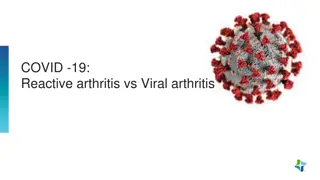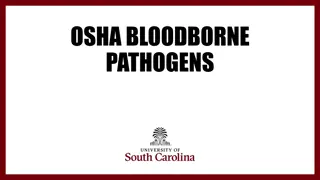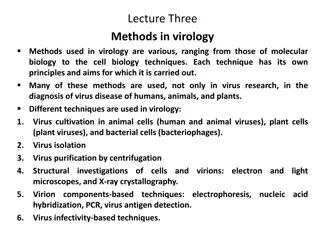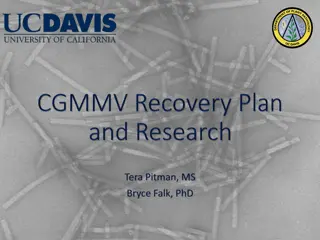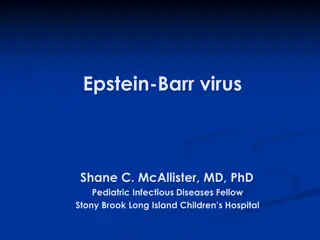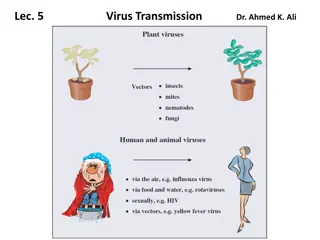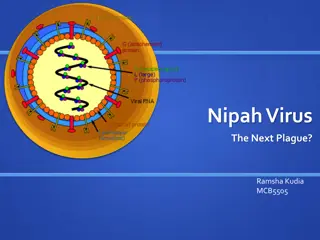Epstein-Barr Virus: Symptoms, Diagnosis, and Risks
Epstein-Barr Virus (EBV), also known as HHV-4, infects B-cell lymphocytes and is commonly associated with infectious mononucleosis. This viral infection can lead to symptoms such as fever, lymphadenopathy, and splenomegaly. Diagnosis is typically confirmed through the presence of specific antibodies, and treatment involves supportive care as antivirals have shown limited efficacy. EBV is linked to various malignancies, including nasopharyngeal carcinoma and Burkitt lymphoma. The differential diagnosis includes other infections like CMV and HIV. Overall, understanding EBV and its associated complications is essential in managing affected individuals.
Download Presentation

Please find below an Image/Link to download the presentation.
The content on the website is provided AS IS for your information and personal use only. It may not be sold, licensed, or shared on other websites without obtaining consent from the author.If you encounter any issues during the download, it is possible that the publisher has removed the file from their server.
You are allowed to download the files provided on this website for personal or commercial use, subject to the condition that they are used lawfully. All files are the property of their respective owners.
The content on the website is provided AS IS for your information and personal use only. It may not be sold, licensed, or shared on other websites without obtaining consent from the author.
E N D
Presentation Transcript
Epstein-Barr Virus Epstein-Barr virus (EBV) (HHV-4) infects oropharyngeal B-cell lymphocytes; latency is established locally and in lymphatic tissue throughout the body. Primary infection mainly occurs when asymptomatic persons shedding EBV in saliva have intimate contact with previously uninfected persons. Most often, infection is asymptomatic and transpires in children and adolescents; antibodies to EBV are present in 95% of adults worldwide. EBV is the most common cause of infectious mononucleosis, characterized by an exudative pharyngitis, fever, and lymphadenopathy (mostly cervical).
Splenomegaly is present in approximately 50% of patients. Other, less frequent findings include jaundice, hepatomegaly, and an erythema multiforme like rash. In most cases, disease spontaneously resolve within 2 to 3 weeks; however, subsequent asthenia may persist for variable periods. EBV is associated with the development of certain malignancies in immunosuppressed and immunocompetent hosts
Diagnosis can be confirmed by the presence of EBV heterophile (Monospot) antibodies or by the detection of EBV-specific antibodies, particularly IgM, to the EBV viral capsid antigen. With mononucleosis, a lymphocytosis typically exists, classically consisting of atypical lymphocytes. Thrombocytopenia, elevated hepatocellular enzymes, lactate dehydrogenase, and bilirubin are other commonly found laboratory abnormalities. Acyclovir and other antiviral agents have not proven beneficial in the treatment of infectious mononucleosis or EBV malignancies. Glucocorticoids should be reserved for complications of EBV, such as a compromised airway or autoimmune hemolytic anemia but in general are not recommended for the treatment of mononucleosis.
Malignancies associated with EBV: 1-NASOPHARYNGEAL CARCINOMA. 2-BURKITT LYMPHOMA. 3-CNS lymphoma (in patients with AIDS). 4-POSTTRANSPLANT LYMPHOPROLIFERATIVE DISORDERS. 5-HAIRY LEUKOPLAKIA 6-Hodgkin lymphoma.
Differential diagnosis of mononucleosis like syndrome: 1-CMV. 2-HIV. 3-HHV-6 4-Herpes simplex virus type 1&2. 5-Group A beta hemolytic streptococcus pyogenes. 6-toxoplasma gondii. 7-Hodgkin and non HODGKIN LYMPHOMA. 8-Rubella. 9-TB adenitis. 10-hepatitis A and B VIRUS.
Human Cytomegalovirus Most cases of cytomegalovirus (CMV) infection (HHV-5) are asymptomatic, and the virus remains latent afterward. Serologic evidence of CMV is present in 60% to 100% of adults worldwide. CMV may spread by close contact through saliva, blood transfusion, organ transplantation, and breastfeeding. Disease acquisition can also occur through congenital or sexual transmission.
Symptomatic primary infection usually manifests as a mononucleosis-like syndrome. Compared with patients who have EBV mononucleosis, patients are usually older and have pharyngitis less often. Fever alone may predominate, making CMV a consideration in persons with fever of unknown origin. The lung, liver, heart, and hematologic and central nervous systems may be involved during primary infection. Latent CMV frequently reactivates in immunocompromised patients. Manifestations of secondary infection include fever, retinitis, pneumonitis, hepatitis, esophagitis, gastritis, colitis, and meningoencephalitis.
Diagnosis relies on isolation of the virus from body fluids, such as urine; detection of CMV pp65 antigen in leukocytes; cytopathic demonstration of owl's eye intracellular inclusions; PCR; and serologic assays. Antiviral treatment is typically indicated in cases of disease reactivation in immunocompromised patients and occasionally in immunocompetent hosts with severe disease,Ganciclovir and valganciclovir are first line agents and can be used as prophylaxis in certain transplant patients.Fascarnet and cidofovir are second line agents.


